Tableau photography/video series / part of the interdisciplinary project Made of Silence, Air, and Glass
STATIONS OF APPEARANCE
photographs: Isak Immanuel / Tableau Stations 2010

During a five and half month stay in Japan (July-December of 2010, as part of a fellowship from the Japan-US Friendship Commission), my attention became drawn into the variant relationships of silence and the reflective mirrors prevalent in the Tokyo metropolis. An effort to create and collaborate in this area was developed and remains open-ended. A resonant inquiry is of bodily presence, social evanescence, and the nature of a gaze in public space. Also of question is what is true, functioning, and inspired friendship and how to cultivate it mutually in a city and long distance. Friendship is a sometimes anomaly and precarious question, particularly as I am an artist and individual drawn to silences and issues of human alienation in the complex environments of a contemporary city. In this way, collaboration takes on very daring forms of confidentiality and subtle nuance.
The photographer Araki Nobuyoshi once remarked: "Tokyo is the loneliest city in the world. Even in crowds, people there live with a strong solitary sense. For example, if they are crossing the street, I get the feeling that all their sadness comes out on the photo, maybe I am the only one to think this, but I believe Tokyo has the highest concentration of sad people in any city".
Personally, as someone who develops a sense of image and body on both sides of a lens, (as watcher and watched), and as an individual frequently passing though public places, I feel I must develop a craft for appearance and disappearance. My activity as an artist is to work in such between spaces of a city where sadness, loneliness, isolation, and other difficult psychological distances form a muteness that may reside close by to another type of silence, such as embodied by insects, the moon, a man reading on a train, or the wind blowing a small branch opposite the side of a glass window. It is an observation that many of the deepest aspects of human perception are in spaces of what is often referred to as silence: an absence filled with life, nuance, and presence. Working with the medium of glass mirror for performance and image making, the disappearance and noise of a body looks to negotiate. Mirrors unfold a series of silent selves. It is an area where portraiture can refract, looking at its own materiality and image with questions of context for a body.
As the areas of an idea of silence related to watching and being watched in the public space of the city is a vital dialogue to understanding the social fabric of urban spaces, I feel work around this theme to be highly beneficial to engaging the cultural paradigms that order and disorder a city body. As an individual who often is living and working in different countries, but also as an American and foreigner to Japan, I present and carry a different type of silence, a different type of distance, body, and reflection or mirror space. This difference is always shifting by nature of relativity, travel, and a dialectics of identity and environment. This I see as an active art of environment and a necessarily humane question of a sense of place.
Some things are difficult in a city, like what is the cultural make-up, psychology, set of instructions, tension, and flexibility for breathing space. How to evaluate such temperaments of air? What are the transparencies, opacities, shatterings, cuts, and reflective qualities found in the glass? Between air and glass, bodies and silence, how do people negotiate orientation? Why does sadness appear? What is the territory of a look and its noise?
- Isak Immanuel
TABLEAU STATIONS
|
Isak Immanuel
INTERDISCIPLINARY DANCE PERFORMANCE

works:















